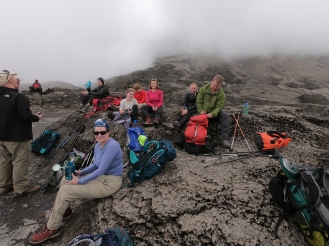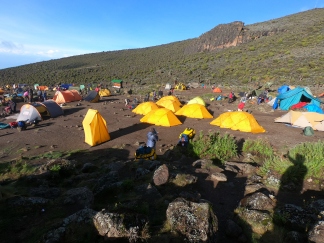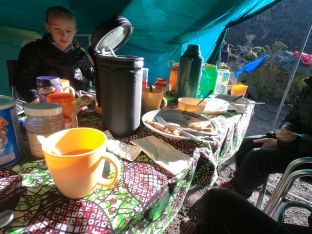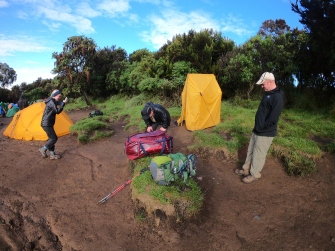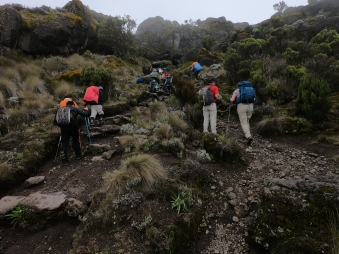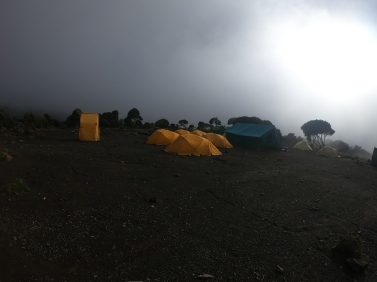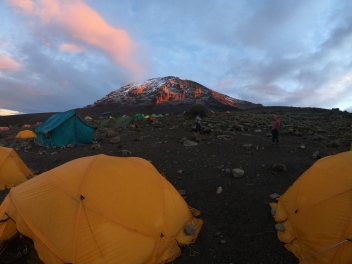
About two years ago, ‘this guy’ and I started planning the trip to Kilimanjaro. Most people probably don’t plan that far out, but given the school breaks and work schedules ( or lack thereof ) , the math dictated this was when we started to sort things out.
End of December through February is usually a good time to climb Mount Kilimanjaro. The short rainy season is supposed to be over by mid-December and the crowds of June – August are only there in June – August. Please note that the short rainy season that was supposed to have been over by mid-December was not over by mid-December.
We took the seven day Machame route. There are six nights of camping on the way up and one night of camping on the way down. There are shorter/quicker routes, but given the ages of the little Stockdales it seemed prudent to make a slow ascent.
The entire climb is fairly structured and you camp each night at set camp sites. Trails are very well maintained. Your porters set everything up and tear everything down each day. There are four porters per climber.
Wake up around 6:00 am. Pack your stuff. Have breakfast around 7:00 am and leave as soon as ‘this guy’ toxifies the surrounding landscape.
Each hike is about 8-12 kilometers ( which is metric for 6-9 miles ) and takes about 6-8 hours. You’re done each day in mid-afternoon and have time to unpack, relax, and rest before dinner at 7:00 pm. Once the sun does down around 7:30 pm the best thing to do is just go to sleep.
Since the short rainy season decided not to be over until after mid-December most of the days hiking consisted of changing into and out of our rain jackets as the light, but steady, rain fell. Each day started with the equatorial sun out and a blue sky. Then the equatorial sun warmed the moist equatorial air which rose up the side of the cold mountain. As the warm and moist equatorial air rose up the cold mountain it found cold air and when the two mix, it rained. The clouds would move in over a matter of minutes. It was neat to watch, however after you spent an hour trying to dry everything off it could be rather disheartening to see all the dryness be replaced with dampness right before your eyes.
Food was good enough. We weren’t staying in five star hotels, but it was warm and you were basically hungry enough to eat almost anything.
It was cold, but not really as cold as we were prepared for. Had it not be raining, a mid-weight fleece and maybe a windproof layer would have been fine. Summit day required a parka. You basically start at sea level and work your way up to 19,000 feet ( which is metric for 5,000 meters ). If the weather is right, Day 1 is shorts and a t-shirt. Then each day you basically add a layer.
Nights were cold, but you have a good sleeping bag. Getting up to utilize the facilities at night is a pain, but the sky is worth it. The little Stockdales had never seen a real night sky after all the years in the big bright cities of Singapore and Seoul and Lake Lotawana.
Each day the terrain changes. Big trees become small trees which becomes green stuff growing on rocks which becomes rocks which becomes snow. The way down is snow which becomes rocks which becomes green stuff growing on rocks which becomes small trees which becomes big trees.
Not showering wasn’t fun, but it’s easier in the cold than the heat.
Each day you go a bit higher up the mountain. On one occasion you descend for a day ( metric for go down ). The idea is to gradually give your body time to adjust to the lower amount of oxygen in the air. At some point we all took medication to assist with the symptoms of altitude sickness. Mostly everyone had their ups and downs ( get it ) from the altitude sickness.
Water came from streams. The porters filtered the water and then we additionally chemically treated the water with iodine tablets. The last thing you want on something like this is some type of gastrointestinal nonsense.
As far as physical ability and necessary training, all that needs to be said is that ‘this guy’ made it and there is a lot more of ‘this guy’ today than when I met ‘this guy’ almost thirty years ago. In all seriousness, you just need to be in good general physical condition and not mind the discomfort, the cold, the wet, and the potential to utilize the facilities after ‘this guy’.
Part 6 will start on summit day with eleven being as loud as we get get. However, as mentioned, nine could only be heard from the summit of Mount Kilimanjaro.






